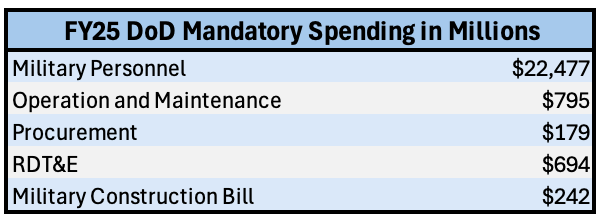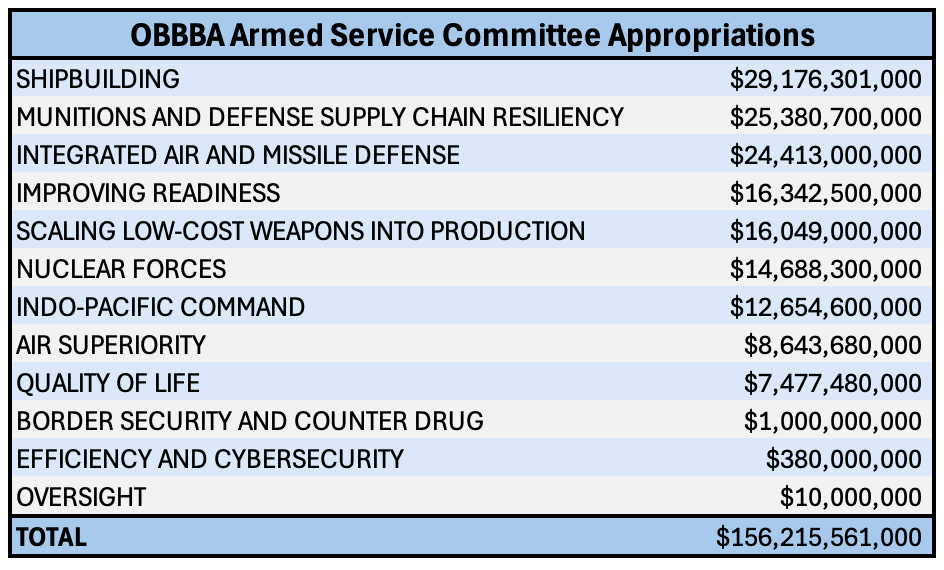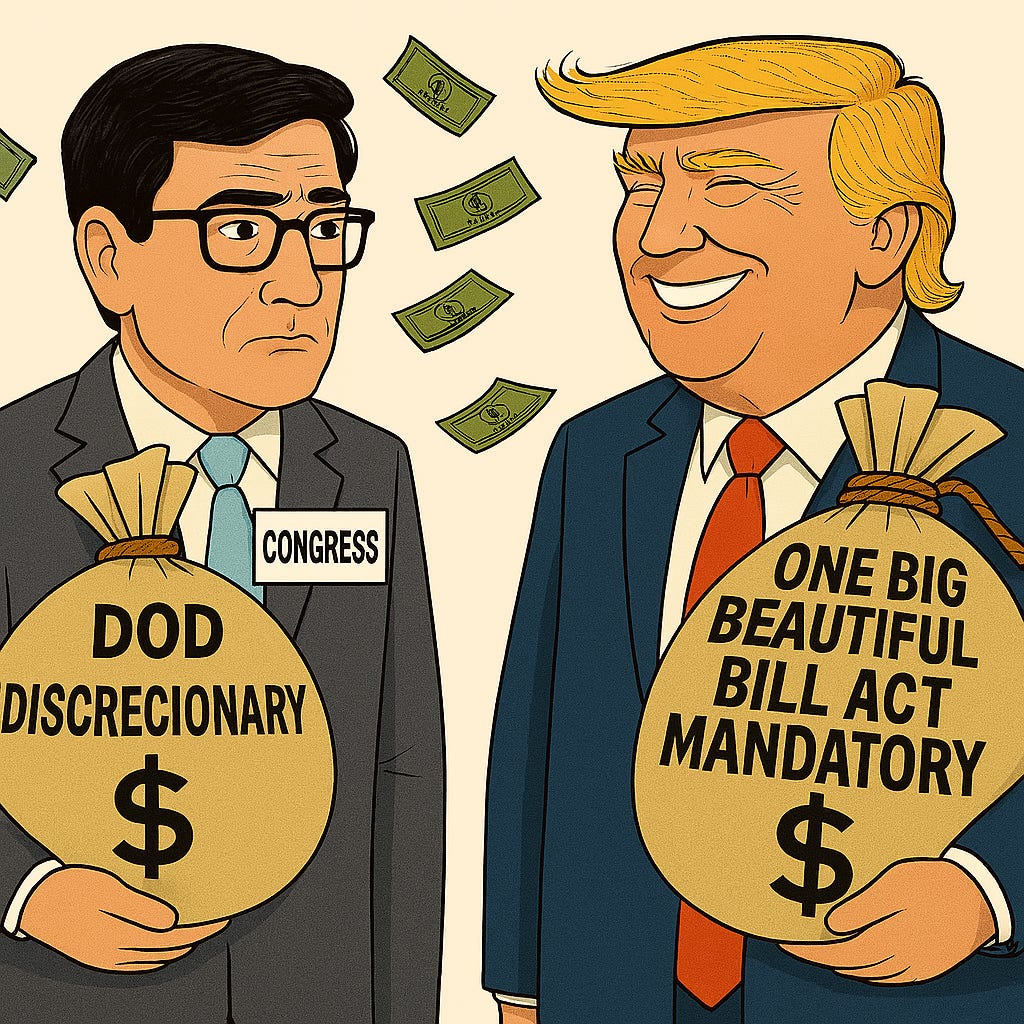The One Big Beautiful Bill Act (OBBA) became law on July 4, 2025. The wide-ranging nature of the bill has made some of its specific contents opaque to observers. The bill has significant implications for Department of Defense spending and marks a departure from the status quo in the Beltway. The bill included over $156 billion in defense appropriations through fiscal year 2029 (FY29). This legislation is significant for reasons beyond the initiatives that received funding. The real game changer is that this tranche of defense appropriations is mandatory rather than discretionary spending, marking a significant shift in defense appropriations.
For context, FY25 mandatory spending for the DoD totaled $22.41 billion, about 92% of which was tied to expenditures for personnel. Of that, most went to retired military personnel through pensions and benefits. In contrast, OBBBA expands the scope of mandatory spending beyond these traditional personnel costs.

The levels of mandatory spending for FY26 were expected to just exceed FY25 levels at $22.5 billion. Over the next four fiscal years, total mandatory spending was expected to total $88.8 billion. Now, with OBBBA, that figure jumps to $245 billion, marking a nearly threefold increase.
Why It Matters
Why should anyone care if funding is mandatory or discretionary? The answer lies in the complex, multistep process that drives the annual approval of discretionary budgets. Here is an abbreviated and simplified version of that process:
1. Service POMs (Program Objective Memorandum): Annually, each service pours blood, sweat, and tears into a detailed five-year spending proposal (the FYDP), laying out its desired programs and priorities.
2. OSD/Joint Staff Review: These proposals are reviewed, adjudicated, and sometimes rewritten during a combative internal cycle.
3. Presidential Budget Request (PBR): The Office of Management and Budget (OMB) packages a final proposal with the rest of the federal budget to send to Congress.
4. Congressional Action: Congress must pass both:
The National Defense Authorization Act (NDAA), which provides the legal authority to execute programs.
The Defense Appropriations Act, which allocates funds from the treasury to provide actual funding for these programs.
Both the NDAA and appropriations bill must be signed into law by the President. And while the Defense Appropriations bill is, in theory, a separate piece of legislation, in practice, it is generally not passed in isolation. It is instead subject to the political horse-trading in the other appropriations bills that comprise the overall federal budget. In practice, Congress often fails to produce a budget on time. When such failures occur, a continuing resolution takes the place of the new budget, often staving off a government shutdown, allowing programs to continue at the funding levels of the previous fiscal year. Continuing resolutions have the unfortunate side effect of forestalling the commencement of new programs that may have been authorized in the NDAA or preventing the growth of existing programs.
Take a deep breath. Did that abbreviated explanation seem like a lot to take in? If so, then you can inherently understand the importance of increasing the scope of mandatory spending. Mandatory spending is largely exempt from the process described above. The mandatory funds made available in the OBBBA are available to the DoD through FY29 without the need for the annual budget rigmarole. It would require subsequent legislation, signed by the president, to remove this mandatory funding — an improbable prospect.
This is more than a funding gimmick — it marks a structural change in defense budgets. Whether it is a one-time exception to the normal process or if this becomes the new normal is yet to be seen.
However, with the FY26 budget expected to approach or even exceed $1 trillion, the $156 billion provided by OBBBA over the next four fiscal years may seem trivial. This indicates that the traditional role of approving discretionary spending will remain vitally important, and Congress has not ceded all of its power to the executive with a single piece of legislation.
However, for the areas included in OBBBA, they have some political breathing room and fiscal predictability over the next four years. These funding areas generally have bipartisan support, but the clear exception is the $1 billion made available to the DoD for border security and counter-drug missions. This is not an area traditionally handled by the DoD, and it is unlikely that a different administration or Congress would have sought inclusion of this area of funding for the DoD. Still, it is worth noting that this is a modest amount compared to other mandatory defense spending categories.

On the other hand, other spending areas are mostly benign from a partisan perspective. Shipbuilding comes in at number one in terms of fiscal resources at $29 billion, and few in either party would argue with the need for resources in that area. Integrated air and missile defense is another significant beneficiary, although some of this support is tied to the administration’s Golden Dome initiative. However, while this is a pet project of the administration, it has not encountered outspoken or clear opposition.
The most notable inclusion on the list of defense spending areas in OBBBA is Indo-Pacific Command, which stands out as the only geographic combatant command included. The bill specifically made funds available for Operations and Maintenance and for each service’s exercise budget in the region. Activity in these areas is critical to regional campaigning, demonstrating commitment to partners and allies, and deterring aggression by China. The pivot to Asia is now over a decade in the making, and while the United States has not always been faithful to this promise, these priorities are communicated clearly in OBBBA.
Conclusion
From the perspective of defense budgets, it is too early to gauge the full impact of OBBBA. As stated, selected spending areas are likely to enjoy some fiscal and political stability, and perhaps find new efficiencies as a result. It is also possible that this bill has simply moved the lines of inevitable political posturing as Congress accounts for this new mandatory spending in its annual deliberations over discretionary spending. Regardless of the outcome, observers should be aware of the shift that OBBBA presents for defense spending and be keen to learn the lessons that will follow.
The views and opinions expressed on War Quants are those of the authors and do not necessarily reflect the official policy or position of the United States Government, the Department of Defense, or any other agency or organization.
Note: Offsetting receipts accounts for the discrepancy in the total between the article text and the table.




Trenchant analysis